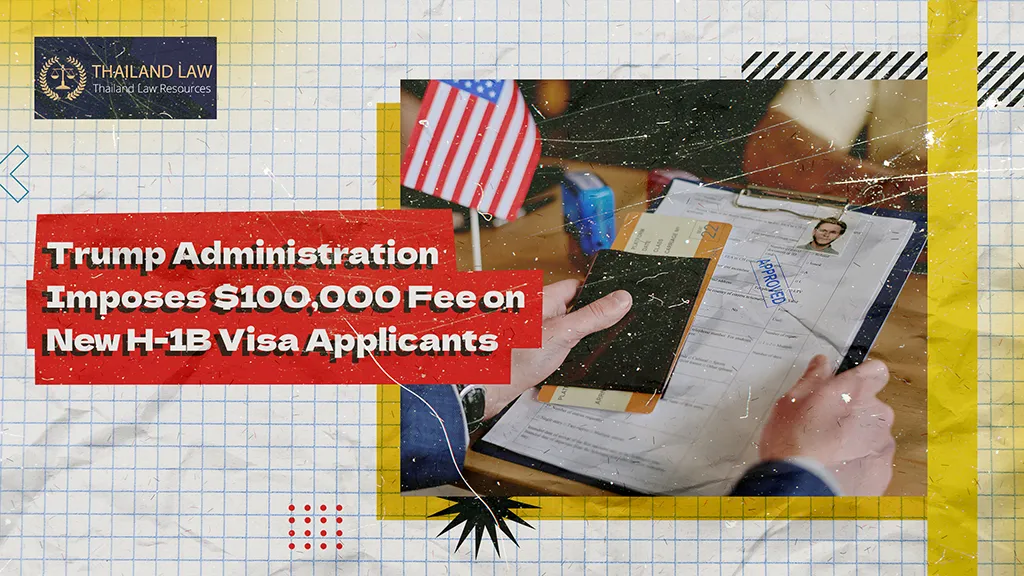
The H-1B visa has long been one of the most important US work visa programs, allowing employers to hire foreign professionals for specialty occupations while offering workers the opportunity to build their careers in the United States. However, with the recent Fee on New H-1B Visa Applicants, both employers and prospective employees must consider the additional costs involved in the application process. Despite this change, the H-1B program remains vital, providing businesses access to global talent in areas with domestic skill shortages and giving employees valuable US work experience and, in many cases, a potential pathway to US permanent residency.
Now, the program is facing a major change. On September 19, 2025, President Donald Trump issued a presidential proclamation titled “Restriction on Entry of Certain Nonimmigrant Workers,” announcing a one-time 100,000 USD government fee on all new H-1B visa petitions, citing the goal of strengthening the US economy and labor market. The order, which took effect on September 21, 2025, requires the visa sponsor to pay the fee unless an applicant qualifies for a national interest exemption.
This extraordinary cost is expected to significantly impact hiring decisions, corporate budgets, and immigration strategies for US companies that depend on international talent.
What is the H-1B Work Visa Program?
The H-1B visa is a US work visa that allows American companies to hire highly skilled foreign professionals in specialty occupations that typically require at least a bachelor’s degree or the equivalent license or certification. To bring an H-1B worker to the US, employers must petition with US Citizenship and Immigration Services (USCIS).
The program is subject to an annual cap of 85,000 new visas, 65,000 for regular petitions, and an additional 20,000 for applicants with a US master’s degree or higher. Because demand regularly exceeds this cap, most new petitions are processed through a lottery system, making the selection highly competitive.
H-1B visas are generally approved for three years and can be extended up to six years. The visa allows dual intent, meaning holders can pursue a green card while maintaining H-1B status. The program is essential for US employers to fill gaps in high-demand fields such as technology, finance, and healthcare.
What the New H-1B Fee Requires
Under the new presidential proclamation, US employers must pay a one-time 100,000 USD surcharge on every new H-1B visa petition filed for a foreign national who is outside the United States at the time of application. This rule takes effect September 21, 2025, and is scheduled to remain in place for 12 months, unless the administration decides to extend or revoke it.
Fortunately, not every H-1B filing is affected. The fee does not apply to:
- Current H-1B holders in the US as of September 21, 2025, 12:01 AM EDT.
- Current H-1B holders with valid visa stamps who travel abroad and return within their visa’s validity period.
- Individuals with H-1B petitions filed before September 21, 2025, including those awaiting visa issuance or entry to the US.
- H-1B workers who are deemed in the national interest of the United States and are determined not to pose a threat to US security or welfare.
Note: It is still unclear whether the rule covers only a visa beneficiary’s first H-1B petition or also later filings like extensions, amendments, or job changes. USCIS says that for now, the fee only applies to new H-1B petitions for beneficiaries outside the United States when filed.
Companies hiring new overseas talent must now plan for an additional six-figure cost per beneficiary. This significant expense could dramatically alter hiring budgets, force companies to prioritize only the most essential international hires, and encourage some businesses to consider alternatives such as remote work, outsourcing, recruiting talent already present in the US, or transferring operations outside of the US.
Impact of the H-1B Proclamation on US Wages for Foreign Workers
By law, employers must pay H-1B workers at least the “prevailing wage” for their occupation and location. The prevailing wage is defined as the average pay earned by similarly employed US workers in the same geographic area. In addition to the new visa fee, the presidential proclamation directs the Department of Labor (DOL) to raise prevailing wage levels, further increasing costs and making compliance more challenging for smaller companies and industries that rely heavily on H-1B talent.
Together, the 100,000 USD surcharge and higher wage mandate amount to one of the most significant changes to the H-1B program in decades. However, the administration maintains that these measures are designed to protect American workers and reduce what it views as misuse of the H-1B system.
How the $100,000 H-1B Fee Affects Employers and Employees
The 100,000 USD surcharge places a heavy financial burden on US employers. Industry analysts estimate that US companies will pay 14 billion USD in added costs over the next year. While large corporations may be able to absorb the fee, smaller businesses and startups, often among the most active H-1B sponsors, will struggle to justify the expense.
For employers, the rule could discourage sponsoring new H-1B candidates altogether, narrowing access to global talent. Many companies may instead:
- Prioritize only critical international hires,
- Shift projects overseas,
- Increase reliance on remote work or outsourcing, or
- Focus recruitment on workers already in the United States.
Foreign workers will be directly affected. Applicants from countries with the highest H-1B demand, particularly India and China, are likely to feel the greatest impact as opportunities decrease and competition for US-based roles intensifies. For many skilled professionals, the new fee could delay or derail career plans in the United States.
H-4 dependents, such as spouses and children of H-1B workers, may also be affected if they plan to live in the United States with their family members. Former H-1B holders who are currently in another immigration category but wish to return to H-1B status could likewise be subject to the new fee. In some cases, even individuals filing extensions, amendments, or change-of-employer petitions may be impacted.
Legal Basis for the H-1B Proclamation
President Trump’s order, officially titled “Restriction on Entry of Certain Nonimmigrant Workers,” relies on the President’s broad authority under Section 212(f) of the Immigration and Nationality Act (INA) to suspend or restrict the entry of noncitizens when it is considered in the national interest. This same legal foundation has been used in past administrations for travel bans and emergency immigration measures, giving the White House wide discretion to limit specific visa categories.
The proclamation also establishes a “national interest exemption” that, in theory, allows certain employers or workers to avoid the $100,000 H-1B fee if they can demonstrate a critical benefit to the United States. Exceptions may be granted for an individual, all employees of a company, or even an entire industry if doing so is deemed in the national interest. However, the criteria and application process for this exemption have not yet been defined, leaving businesses uncertain about how to qualify or what evidence will be required.
Industry and Global Reaction
Major US technology companies like Amazon, Microsoft, Google, and Meta have already begun issuing internal memos and revising hiring strategies in response to the new H-1B visa fee. Industry groups warn that the policy will worsen existing talent shortages, increase reliance on outsourcing, and weaken US competitiveness in the global market for highly skilled professionals.
The international response has also been vocal. Foreign governments, particularly India, which supplies the majority of H-1B workers, have raised concerns over the rule’s impact on their nationals and on bilateral economic ties. Diplomatic pressure and possible legal challenges may follow, as affected countries seek to protect the interests of their skilled workforce and maintain access to US employment opportunities.
Legal Challenges and Unanswered Questions about the New H-1B Fee
The 100,000 USD H-1B visa fee is expected to face significant legal scrutiny. Immigration experts are already questioning whether the presidential proclamation exceeds the statutory authority granted under the INA, raising the likelihood of court challenges in the months ahead.
Another area of uncertainty is the “national interest” exemption. The rule allows certain employers or workers to request a waiver, but the criteria and application process have not yet been defined. Until the government provides clear guidance, businesses will be left guessing about eligibility and how to demonstrate that an H-1B petition meets the national interest standard.
Employers and foreign professionals must also prepare for the possibility that the fee could be extended beyond the initial 12-month period. Without a clear end date, long-term workforce planning remains highly uncertain.
What H-1B Employers and Workers Should Do Now
The 100,000 USD surcharge is already in effect as of September 21, 2025, and its financial impact is too significant for businesses and workers to ignore.
Companies may respond by:
- Reviewing budgets, recruitment pipelines, and project timelines for the next 12 months.
- Reserving sponsorship for critical hires where the expense can be justified.
- Exploring alternatives such as outsourcing, remote work, or focusing on candidates already in the US.
- Evaluating whether a national interest exemption could apply to essential positions.
For foreign workers, it’s important to stay prepared. H-1B applicants and visa holders should:
- Closely track policy updates, litigation, or administrative changes that may alter or overturn the rule.
- Discuss with employers whether an exemption may be possible.
- Anticipate greater competition for US-based roles as opportunities decrease.
Although lawsuits or a change in administration could eventually reshape the policy, the surcharge remains enforceable for now. Both employers and employees should plan under the assumption that the 100,000 USD fee will govern H-1B hiring decisions in the year ahead.
US Immigration Attorney in Thailand
The recent changes to US immigration rules create new challenges for both employers and foreign professionals, making it more important than ever to seek reliable guidance before making major decisions.
Siam Legal, a US-managed law firm headquartered in Thailand, helps Thai citizens and their families successfully navigate the US visa process. Our US Visa Team provides comprehensive, start-to-finish support, including:
- Assessing eligibility and explaining the latest immigration requirements.
- Reviewing documents to reduce the risk of errors or missing information.
- Strategic planning to minimize costly delays or setbacks.
With years of experience and a commitment to staying up-to-date on immigration policy, we provide accurate, practical advice tailored to your situation.
Contact Siam Legal today to learn how current immigration changes may affect you and your family.



